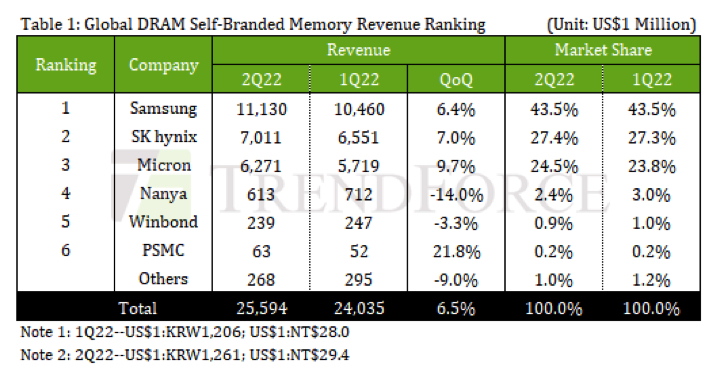WW 2Q22 DRAM Revenue Grows by 6.5% Q/Q at $25.6 Billion
Sustained by upsurge in bit shipments
This is a Press Release edited by StorageNewsletter.com on August 18, 2022 at 2:02 pmAccording to TrendForce Corp.‘s investigations, 2Q22 DRAM industry revenue reached $25.59 billion, growing 6.5% Q/Q.
The primary reason for 2Q22 revenue growth stemmed from an increase in bit shipments from certain DRAM suppliers. Although PC and mobile DRAM were hit hard by inflation and weak demand, momentum in the server DRAM market remained strong in 1H22, driving quarterly shipment growth at the three top manufacturers to 5~10%.

In terms of revenue, the top manufacturers consisting of Samsung, SK Hynix, and Micron, all saw revenue growth with the 2 Korean companies accounting for a combined market share of 70.9%.
Micron benefited from demand for servers and automobiles with its 2Q22 revenue reaching $6.27 billion, an increase of 9.7% Q/Q and highest among the 3.
Driven by revenue growth, each company’s operating margins moved up slightly with Samsung, SK Hynix, and Micron margins reaching 50%, 43%, and 41.5%, respectively.
Looking forward to 3Q22, due to escalating manufacturer-side inventory pressure, pricing support levels have fallen significantly and growth on the shipment-side has become labored due to the impact of customer inventory adjustment. Revenue posted by Samsung, SK Hynix, and Micron is likely to decline.
In terms of production capacity planning, Samsung’s wafer starts continued to increase this year, and each factory is close to full capacity. While Samsung’s new P3L plant will start contributing to the production of DRAM products early next year and give priority to DRAM products using the 1alpha nm process, significantly increasing the proportion of 1alpha nm production.
SK Hynix’s wafer starts also increased slightly, at campuses such as its M16 plant in South Korea and its Wuxi plant in China. However, since M10 was migrated to logic products, total wafer starts only received a marginal boost. The M16 plant still has room to expand but considering a pessimistic demand outlook, production at this plant is only expected to increase slightly in 2023.
Micron has no new production capacity for overall wafer starts this year and the purpose of purchasing machinery is to maintain wafer start volume when processes advance. At the same time, Micron introduced the 1alpha nm process in 2H21 and the 1beta nm will be put into production at its Japan factory at the end of this year. After yield rate improves to a certain level, ma3three major DRAM manufacturers when introducing processes.
In terms of Taiwanese factories, Nanya produces a higher proportion of consumer DRAM. Due to the impact of lockdown policies on domestic Chinese demand, shipments declined significantly and overall revenue decreased by 14.0% Q/Q. Construction of the company’s new Fab5A plant has begun with a completion date of 2025. Until the new factory is completed, annual output is only expected to increase marginally.
PSMC’s revenue calculation is primarily for its in-house standard DRAM products and does not include its DRAM foundry business. DRAM revenue increased by approximately 21.8%, mainly due to the company’s capacity allocation. As its foundry production capacity was revised down, it marginally increased its in-house production of standard DRAM, but if foundry revenue is added, a decreased of 1.0% is realized.
Winbond’s revenue declined slightly by 3.3%, mainly due to inventory corrections among networking customers and a suspension of supply from TV manufacturers resulting in a decline in shipments. At present, Winbond’s Kaohsiung plant will be entirely dedicated to 25S nm production and mass production of the next-gen 20nm process is expected in mid-2023, effectively driving revenue growth.













 Subscribe to our free daily newsletter
Subscribe to our free daily newsletter

